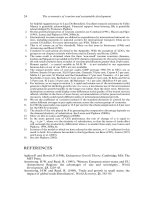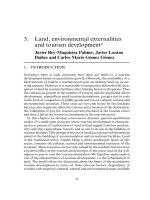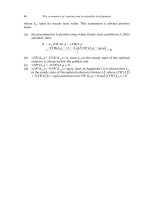THE ECONOMICS OF MONEY,BANKING, AND FINANCIAL MARKETS 657
Bạn đang xem bản rút gọn của tài liệu. Xem và tải ngay bản đầy đủ của tài liệu tại đây (42.71 KB, 1 trang )
CHAPTER 24
Aggregate Demand and Supply Analysis
625
Profit on a unit of output equals the price for the unit minus the costs of producing it. In the short run, costs of many factors that go into producing goods and
services are fixed; wages, for example, are often fixed for periods of time by labour
contracts, and raw materials are often bought by firms under long-term contracts
that fix the price. Because these costs of production are fixed in the short run,
when the overall price level rises, the price for a unit of output will rise relative to
the costs of producing it, and the profit per unit will rise. Because the higher price
level results in higher profits in the short run, firms increase production, and the
quantity of aggregate output supplied rises, resulting in an upward-sloping shortrun aggregate supply curve.
Frequent mention of the short run in the preceding paragraph hints that the
relationship between the price level and aggregate output embodied in the
upward-sloping, short-run aggregate supply curve (AS1 in Figure 24-3) may not
remain fixed as time passes. To see what happens over time, we need to understand what makes the aggregate supply curve shift.
Shifts in the
Short-Run
Aggregate
Supply Curve
We have seen that the profit on a unit of output determines the quantity of output
supplied. If the cost of producing a unit of output rises, profit on a unit of output
falls, and the quantity of output supplied at each price level falls. To learn what this
implies for the position of the aggregate supply curve, let s consider what happens
at a price level of P1 when the costs of production increase. Now that firms are earning a lower profit per unit of output, they reduce production at that price level, and
the quantity of aggregate output supplied falls from point A to point A*. Applying
the same reasoning at point B indicates that the quantity of aggregate output supplied falls to point B*. What we see is that the short-run aggregate supply curve
shifts to the left when costs of production increase and to the right when
costs decrease.
Factors That
Shift the
Short-Run
Aggregate
Supply Curve
The factors that cause the short-run aggregate supply curve to shift are the ones that
affect the costs of production: (1) tightness of the labour market, (2) expectations
of inflation, (3) workers attempts to push up their real wages, and (4) changes in
production costs that are unrelated to wages (such as energy costs). The first three
factors shift the short-run aggregate supply curve by affecting wage costs: the fourth
affects other costs of production.
If the economy is booming and the
labour market is tight (Y
Yn ), employers may have difficulty hiring qualified
workers and may even have a hard time keeping their present employees. Because
the demand for labour now exceeds supply in this tight labour market, employers
will raise wages to attract needed workers, and the costs of production will rise.
The higher costs of production lower the profit per unit of output at each price
level, and the short-run aggregate supply curve shifts to the left (see Figure 24-3).
By contrast, if the economy enters a recession and the labour market is slack
(Y Yn ), because the demand for labour is less than the supply, workers who cannot find jobs will be willing to work for lower wages. In addition, employed workers may be willing to make wage concessions to keep their jobs. Therefore, in a
slack labour market in which the quantity of labour demanded is less than the
quantity supplied, wages and hence costs of production will fall, the profit per unit
of output will rise, and the short-run aggregate supply curve will shift to the right.
The effects of tightness of the labour market on the short-run aggregate supply
curve can be summarized as follows: When aggregate output is above the
TIGHTNESS OF THE LABOUR MARKET









